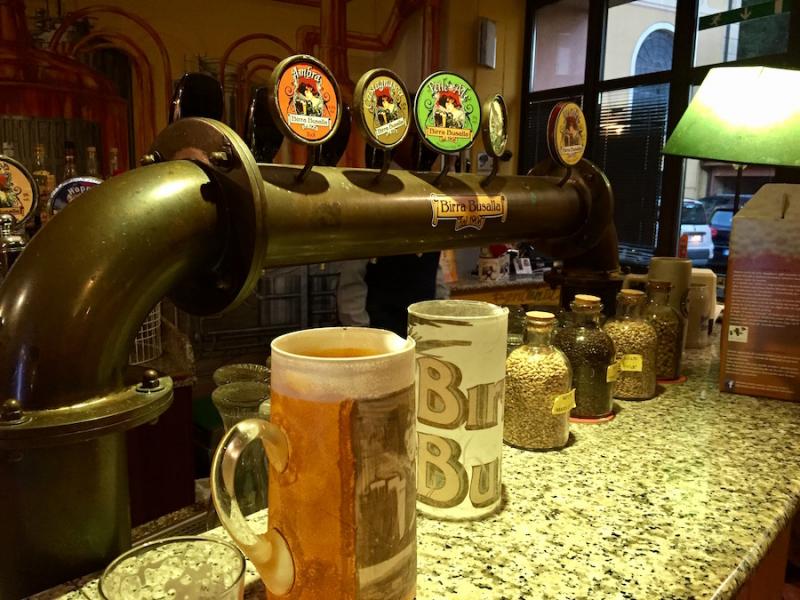Situated along the Scrivia river about 27 kilometers north of Genoa, there is a small town called Busalla. You’ve probably never heard of it, nor might you ever if it weren’t for one thing: beer. In other words, you don’t just go to Busalla for the sake of visiting Busalla. You go for the beer and Busalla Brewery has got plenty of it.
I meet Lorenzo, the current owner and brew-mastermind of Busalla Brewery, outside in the parking lot. Behind him a small glass windowed building showcases the brewery’s production site with large silver vats and barrels full of yeast-like product. On the right I can’t help but notice a very aptly named hotel called Hotel Birra.
Lorenzo shows us into the Brew Pub, the brewery’s very own restaurant. The staff are busy setting up for tonight’s dinner and there are a lot of tables and chairs being jostled about. It’s a warm atmosphere and there’s beer paraphernalia just about everywhere: old pint glasses, wooden crates for shipping beer, and quotes about beer painted on the light yellow walls.

We sit down at one of the wooden tables as Lorenzo fixes us a few glasses of beer. “Coriander and black pepper,” he explains, plopping down the small tasting glass on top of a coaster. My eyes are immediately drawn to the portrait image of a woman on the coaster: half-smiling, her pale face and shoulders donned in purple feathers; her head gently rests just above three tall pints of beer. “The Madonna of Beer,” I can’t help thinking to myself. Later, Lorenzo explains later that this Liberty Woman is the brewery’s logo.

After a few sips of beer, Lorenzo begins to detail the history of the brewery. Opening its doors in 1906, Busalla Brewery was founded by three Genovese entrepreneurs: Giacomo Ricchini, Giovanni Bagnasco and Sisto Poggi. It was one the first breweries in Italy and the decision to open was a risky one, considering that most Italians preferred wine. However, despite this notion, Busalla Brewery defied all odds. During its initial years, the brewery had a production capacity of 25,000 hectolitres (hl) per year - a shocking number considering the technology and means of transport available in the early 1900s. “You could consider that an industrial brewery,” says Lorenzo and indeed, when compared to the 700 hl per year that Busalla brewery produces today, it’s astounding.
The war brought hard times for the brewery and in 1929, Busalla Brewery was forced to close. During WWII the old brewery building functioned as a hospital and aided in other war time operations, but without supplies and the ability to export their product, they couldn’t produce any beer. Poggi and his team ceased operations and surrendered their beloved brewery. For decades, various proprietors owned the old brewery building. It was sometimes used as a warehouse but without desperately needed renovations, it remained closed and uninhabitable.
That is until 1999, exactly 70 years after its closing, when Lorenzo and his partners decided to reopen the historical Busalla Brewery.
He says it all began in the mid-90s when, following in the wake of the American craft beer movement, Italy took an increased interest in beer. He says that one day he and his partners had a sort of “light bulb” moment: “We were talking about this new business when my ex-partner turned and said to me, ‘Did you know that in Busalla there’s an old building where they made beer in the early 1900s? It’s called Birra and the furniture and the building are still intact.’” Lorenzo claims that was when it all clicked.
From there, Lorenzo and his colleagues started studying. “At the time there wasn’t any training on beer in Italy,” Lorenzo tells me. He explains that if you were an Italian wanting to learn how to make beer, your best shot was to go to Germany. Which is exactly what Lorenzo did. With the help of a German braumeister called Mattias Müller, Lorenzo was able to make his first beer: a pale lager named after the man that helped him make it - Müller. Funnily enough, the Mülller beer remains the most popular beer at the Busalla Brewery. “It has a very clean flavor and it’s easy to pair with food,” Lorenzo explains. “It also has a low alcohol content making it a very drinkable beer.”

Lorenzo tells me that the difficult part was more than just learning how to make beer, but also how to open a brewery in Italy. “There were only a few [craft breweries] in Italy at that time,” he says, “and fortunately they were located quite near [Liguria]...in Piedmont and Lombardy which made it was easy to go there and start to get some information about how to open a brewery.” He says that they learned a lot on how to maneuver Italy’s bureaucratic obstacles from the handful of Italian breweries that existed at that time.

After learning how to make basic beer and set up the brewery, Lorenzo and his team started experimenting with different styles, flavors and techniques. When asked what their most particular beer is, Lorenzo’s eyes light up proudly as he says “the Castagnasca.” It’s made with stoneground chestnut flour, a product typical of the surrounding Liguria region. Although Busalla Brewery was the first in Italy to produce a chestnut beer, other Italian breweries since then have experimented with chestnut flavors. Lorenzo is proud but modest when he tells me, “Today we can say that beer made with chestnut flour is considered an Italian beer.”
Since then, Lorenzo says interest in craft beer has grown drastically in Italy. “It’s not that now Italy is crazy about craft beer -- the percentage of craft beer drinkers is still quite small. However... now people aren’t simply asking for a blond beer, a red beer or a dark beer -- they’re asking about styles.” Lorenzo has even started instructing courses on beer. He says the demand is there that wasn’t there when he first started getting into the business. “Now you can do beer tasting courses and even advanced courses on beer...15 years ago you didn’t have that possibility.”

Despite this growing interest, Busalla Brewery’s production and distribution remain concentrated. Outside the brewery, their beer can be found only at local restaurants, pubs and hotels. When I ask Lorenzo about their distribution he tells me very matter of factly that he made a conscious choice to keep things small. “It allows me to follow the product at every stage,” explains Lorenzo. “Now many tourists are coming [to Liguria] and asking for local beer...so that’s where we fit in.”
Of course it’s not just about producing beer to sell on the market. Lorenzo also has the Brew Pub restaurant to keep up with, a business he started to meet market demand. “In Italy, you drink because you eat,” he tells me through a jolt of laughter. “One of the first things Italians ask for when they order a drink is to have a few potato chips or something to snack on. Our beer is still the foundation of it all, but [at the Brew Pub] our beer can be paired with food.” Lorenzo says he had to focus his attention not just on making good beer, but also food in order to attract Italian customers.
When looking around at the staff busily setting up for the night, it seems like it was a right decision. “We’re completely booked tonight,” says Lorenzo apologetically, as if it were a bad thing.
Want to visit Busalla Brewery? Tours and tasting can be booked by appointment only. Make an appointment by filling in the contact form on their website or send an email to info@birrabusalla.it.
The Brew Pub Restaurant is open Tuesday - Sunday from 6pm onwards. To make a reservation call +39 010 9640161.
Fabbrica Birra Busalla
Località Birra, 3
16010 Savignone (GE)








